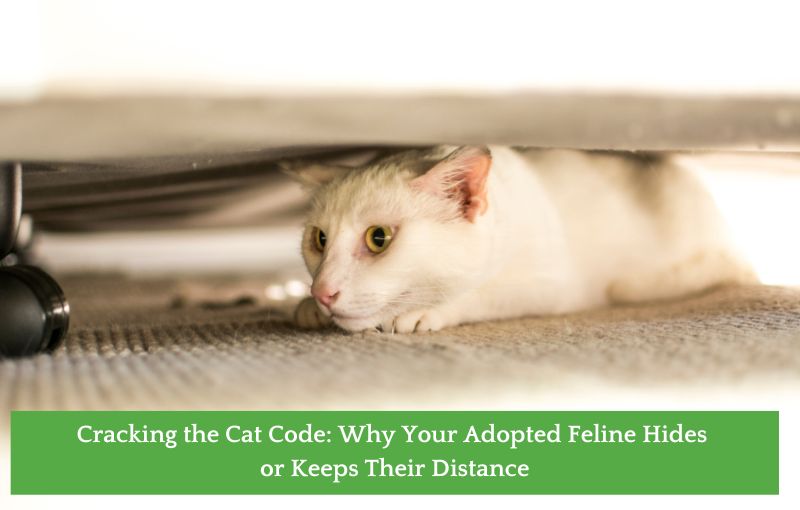
Bringing a new cat into your home can be an exciting experience, but not all cats settle in right away. Some cats may hide, seem distant, or act uninterested in their new surroundings. While this behaviour can be concerning, it’s usually part of the adjustment process. Understanding why your adopted cat acts this way and how to address it will help you create a safe, loving environment where your cat can thrive.
Why Adopted Cats Hide or Act Distant
- Adjusting to a New Environment
- Moving to a new home is stressful for cats, especially those with a history of neglect or multiple rehomings. A new environment comes with unfamiliar smells, sounds, and routines, which can make them feel overwhelmed.
- Fear and Insecurity
- Cats are territorial by nature. When they lose familiar territory, they may feel vulnerable and seek safety by hiding. This is especially true if your cat had a difficult past or limited positive interactions with people.
- Overstimulation and Sensory Overload
- Adopted cats might feel overwhelmed by a busy household with too much activity, noise, or unfamiliar people. Some cats need time to acclimate to these stimuli and prefer to observe from a distance before engaging.
- Independent Personality
- Some cats are naturally more independent or introverted. They may need more time to build trust and bond with their new human companions, preferring to interact on their terms.
How to Help Your Cat Feel More Comfortable
1. Create a Safe, Quiet Space
Provide your cat with a private, comfortable area where they can hide and relax. This could be a separate room or a cosy nook with a bed or blanket. Make sure they have access to essential items like food, water, and a litter box in this space. Giving them time to feel safe in their environment will encourage them to explore when they’re ready.
2. Respect Their Boundaries
Avoid forcing your cat to interact with you or anyone else. Let them come to you on their terms. Cats often show affection subtly, like rubbing against your leg or sitting nearby. Reward these small moments with gentle words or treats to encourage more interaction.
3. Use Positive Reinforcement
Reinforce good behaviour by offering treats, praise, or toys when your cat is calm and confident. Avoid punishment, as it can increase fear and erode trust. Patience is key—building a bond takes time, especially with cats that have had challenging past experiences.
4. Engage Their Curiosity with Play
Playtime helps build trust and strengthens the bond between you and your cat. Use interactive toys like wand teasers, balls, or laser pointers to engage their hunting instincts. Allow your cat to “win” the game occasionally by catching the toy to boost their confidence.
5. Monitor Body Language
Learning to read your cat’s body language is essential for understanding their emotional state. Signs like slow blinking, relaxed ears, and a raised tail indicate comfort, while flattened ears, dilated pupils, or a puffed tail suggest fear or stress. Respecting these cues will help your cat feel safe.
6. Introduce Changes Slowly
If you need to introduce new elements, such as other pets or unfamiliar visitors, do so gradually. Start with scent swapping—exchange bedding between pets to familiarise them with each other’s scent. When introducing new people, ask them to approach slowly, giving your cat the option to interact.
7. Use Calming Aids if Necessary
Some cats benefit from pheromone sprays or diffusers like Feliway, which mimic calming feline pheromones. These can be particularly helpful during the adjustment period to reduce stress and encourage exploration.
When to Be Concerned
While most cats will adjust to their new home with time, there are some signs that may require further attention:
- Refusing to eat or drink for more than 24 hours.
- Persistent hiding with no signs of exploration.
- Aggressive behaviour toward people or other pets.
If your cat shows any of these behaviours, it’s a good idea to consult with a vet or animal behaviourist. There could be underlying medical issues or trauma that need to be addressed.
Building Trust Takes Time
It’s important to remember that every cat is unique, and some take longer than others to feel comfortable in a new environment. Be patient and consistent with your care and affection. Over time, your cat will learn to trust you and become more engaged in your household. Celebrate the small moments of connection—whether it’s a gentle purr, a rub against your leg, or a playful swat at a toy. These are all signs that your cat is starting to feel at home.
Conclusion
Helping your adopted cat feel comfortable and secure is a gradual process, but with patience, love, and understanding, they will come out of their shell. Respecting their boundaries, creating a safe space, and offering positive reinforcement will foster trust and build a strong bond. Remember, every step forward, no matter how small, is progress toward a happy and confident feline companion.

